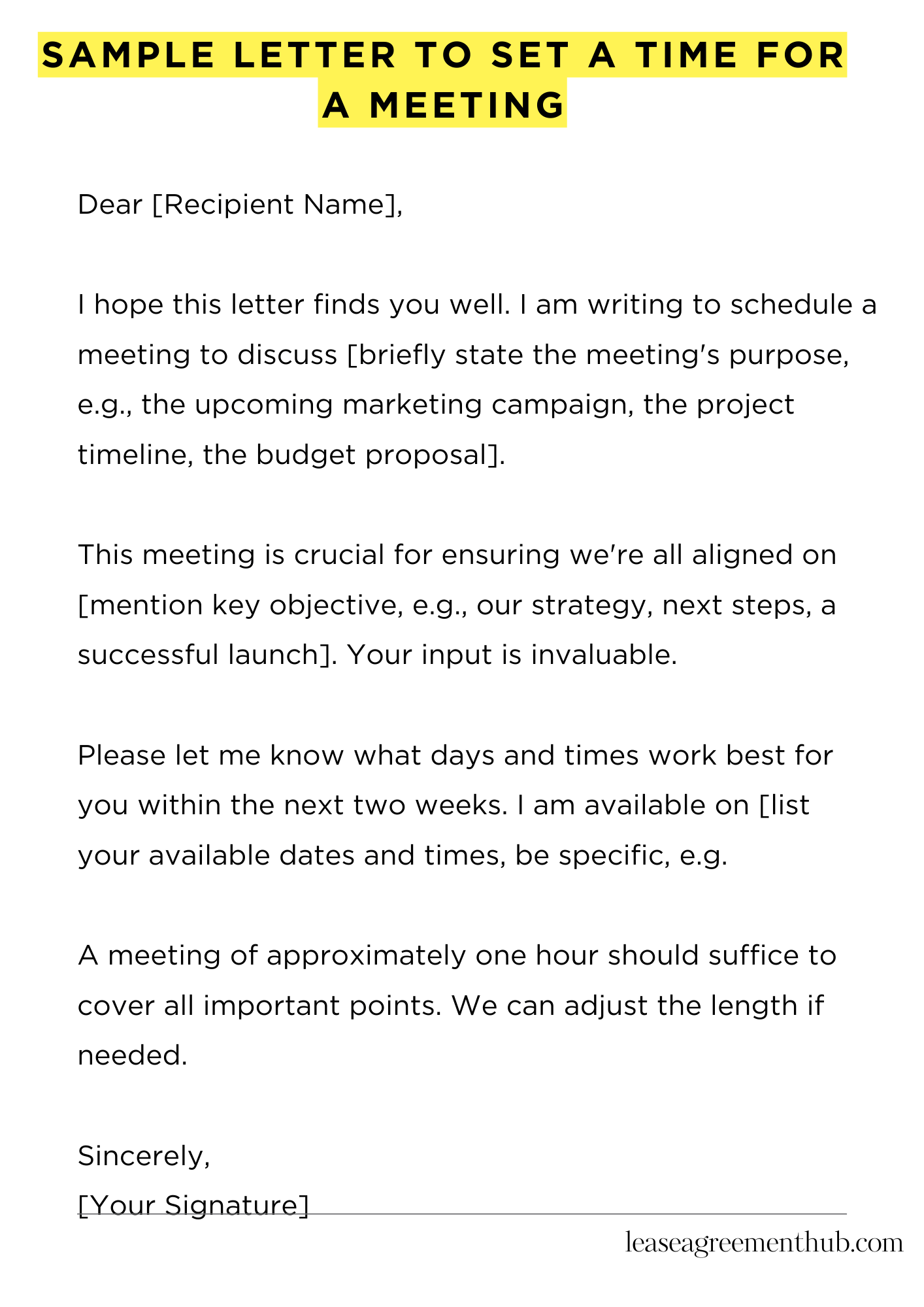Need to schedule a meeting? A sample letter helps. It makes requesting a meeting time easy.
This article gives you examples. Use them as templates. They’ll help you write your own meeting request letter.
These samples are easy to adapt. You can customize them. Write the perfect letter quickly.
sample letter to set a time for a meeting
[Your Name/Company Name]
[Your Address]
[Your Phone Number]
[Your Email Address]
[Date]
[Recipient Name]
[Recipient Title]
[Recipient Company]
[Recipient Address]
Dear [Recipient Name],
I hope this letter finds you well. I am writing to schedule a meeting to discuss [briefly state the meeting’s purpose, e.g., the upcoming marketing campaign, the project timeline, the budget proposal].
This meeting is crucial for ensuring we’re all aligned on [mention key objective, e.g., our strategy, next steps, a successful launch]. Your input is invaluable.
Please let me know what days and times work best for you within the next two weeks. I am available on [list your available dates and times, be specific, e.g., Tuesday afternoon, Wednesday morning, Thursday after 2 PM]. We can meet in person at your office or virtually, whichever you prefer. We can also explore other options if necessary.
A meeting of approximately one hour should suffice to cover all important points. We can adjust the length if needed.
I look forward to hearing from you soon and confirming a suitable time to meet.
Sincerely,
[Your Signature]

How to Write a Sample Letter to Set a Time for a Meeting
The Imperative of Precision: Crafting Your Salutation
The initial salutation sets the tone for your entire correspondence. Avoid casual greetings. Instead, opt for a formal and respectful opening, such as “Dear Mr./Ms./Mx. [Last Name],” Precision in addressing the recipient is paramount. A misspelled name immediately undermines your credibility. Remember, first impressions are indelible.
Articulating Your Purpose: Concisely Stating Your Objective
Directness is key. Your letter’s purpose is singular: to schedule a meeting. Avoid circumlocution. Begin by clearly stating your intention. For example: “I am writing to request a meeting to discuss [briefly state the meeting’s topic].” This upfront approach demonstrates respect for the recipient’s time.
Proposing Specific Times: A Demonstrative Display of Consideration
Don’t leave scheduling to chance; suggest concrete times. Proffer at least two or three specific date and time options. This demonstrates consideration for the recipient’s schedule, showcasing your proactive approach. Offering flexibility is advantageous, but remember to maintain a professional demeanor.
Providing Context: Illuminating the Rationale Behind the Meeting
Briefly explain the necessity of the meeting. This contextualization strengthens your request. A concise yet informative overview of the subject matter will help secure the meeting. Keep it succinct, avoiding unnecessary details. Think of it as an executive summary.
Concluding with a Call to Action: A Cogent and Courteous Summation
Reiterate your request and provide contact information for swift response. A clear call to action ensures your letter is not misconstrued. End with a professional closing, such as “Sincerely,” followed by your typed name and contact details. This facilitates a prompt and efficient response.
Ensuring Readability: Adherence to Grammatical Propriety and Formatting
Grammatical accuracy and proper formatting are non-negotiable. Proofread meticulously for errors. A well-structured, grammatically correct letter conveys professionalism and respect. Use a professional font, such as Times New Roman or Arial, and maintain consistent formatting throughout.
The Importance of Follow-Up: A Necessary Postscript
If you haven’t received a response within a reasonable timeframe (e.g., two business days), a polite follow-up email or phone call is perfectly acceptable. This demonstrates persistence without being intrusive. Remember, effective communication requires proactive engagement.
FAQs about sample letter to set a time for a meeting
Scheduling meetings effectively is crucial for productivity. A well-crafted letter can significantly improve the chances of a successful meeting arrangement.
What is the best way to start a letter requesting a meeting?
Begin with a polite and professional salutation, followed by a brief, clear statement of your purpose. For example: “Dear [Name], I am writing to request a meeting to discuss [topic].” Avoid overly informal language.
How should I propose specific meeting times in my letter?
Offer a few specific date and time options that work for you. This demonstrates preparedness and respect for the recipient’s schedule. Provide alternatives, such as “Would you be available on [Date] at [Time] or [Date] at [Time]?”
What information should I include in the body of the letter?
Clearly state the purpose of the meeting, briefly outlining the key topics to be discussed. Mention the expected duration of the meeting and the desired outcome. If relevant, include any necessary background information or documents.
How can I ensure my letter is professional and concise?
Keep the letter brief and focused on the essential information. Use clear and concise language, avoiding jargon or overly complex sentences. Proofread carefully for any grammatical errors or typos before sending.
How should I conclude a letter requesting a meeting?
End with a polite closing, such as “Sincerely,” or “Regards,” followed by your name, title, and contact information. Reiterate your availability and express your eagerness to meet. You might also include a sentence expressing gratitude for their time and consideration.
Related: